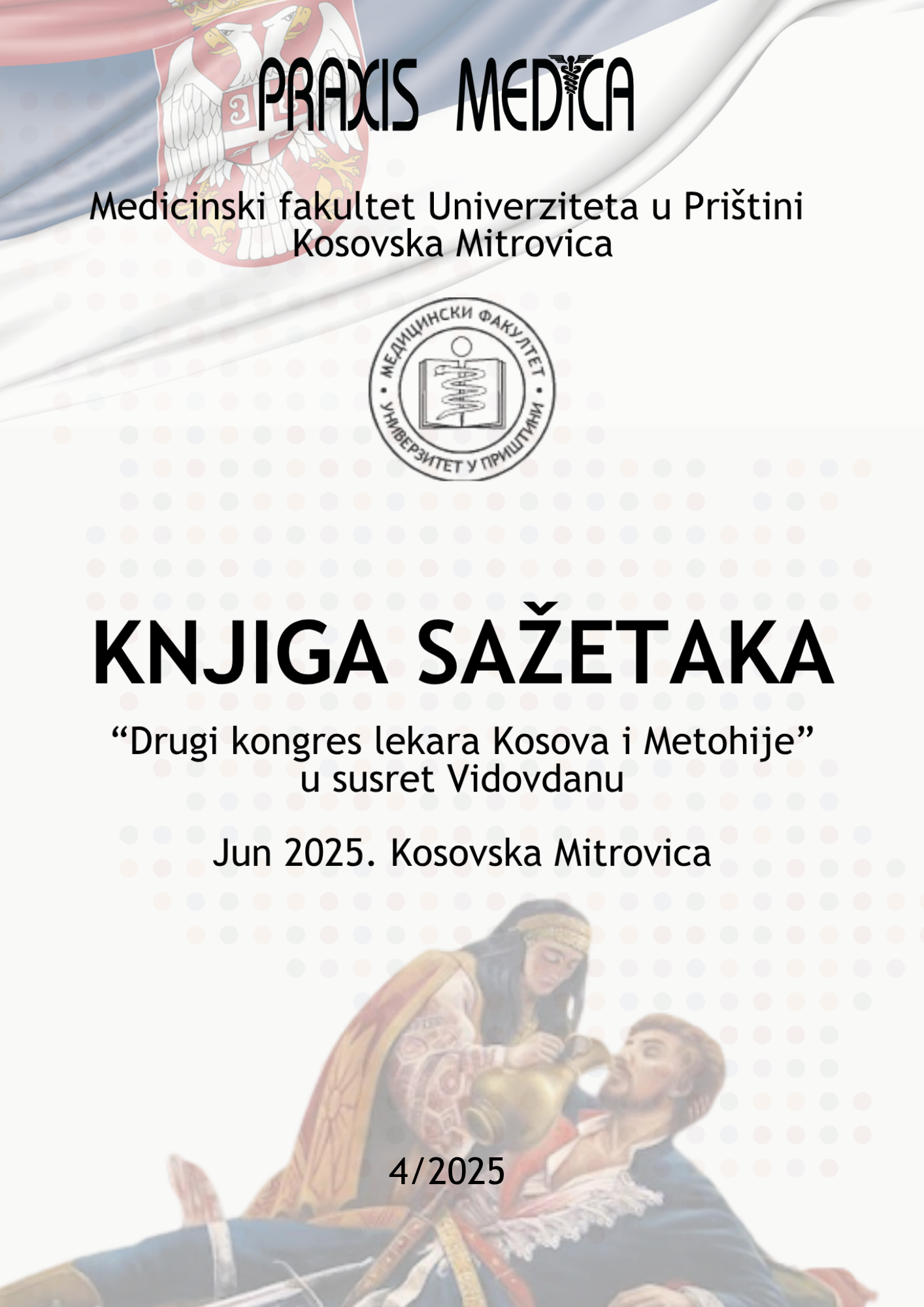Current issue

Volume 53, Issue 4, 2025
Online ISSN: 2560-3310
ISSN: 0350-8773
Volume 53 , Issue 4, (2025)
Published: 30.06.2025.
Open Access
All issues
Contents
15.02.2025.
Case Reports
IDIOPATHIC PULMONARY HYPERTENSION – CASE PRESENTATION
Pulmonary hypertension (PH) is a hemodynamic condition characterized by a mean pulmonary artery pressure (mPAP) ≥ 25 mmHg at rest, pulmonary arterial wedge pressure (PAWP) ≤ 15 mmHg, and pulmonary vascular resistance (PVR) > 240 dyn·s·cm⁻⁵. The annual incidence of pulmonary arterial hypertension (PAH) is approximately 3–10 new cases per million adults. It is estimated that the prevalence of pulmonary hypertension in individuals over 65 years of age is around 10%.The aim of this study is to present the case of a female patient with progressive dyspnea in whom PAH remained undiagnosed for a prolonged period.A 74-year-old female patient, M.P., was hospitalized in the Coronary Care Unit of the Clinical Center in Kosovska Mitrovica due to symptoms of shortness of breath, choking, fatigue, leg swelling, and weakness. The admission ECG revealed: sinus rhythm, normal axis, high R wave in V2, ST depression, and negative T waves in leads II, III, aVF, and V4–V5. Echocardiography findings showed right ventricular enlargement (2.9 cm), pulmonary artery dilation (3.3 cm), 1–2+ pulmonary regurgitation, and 3+ tricuspid regurgitation, with a systolic pulmonary artery pressure (SPAP) of up to 126 mmHg. The right ventricle measured 5.3 cm in the 4Ch view, with a TAPSE of 1.8 cm. Right heart catheterization revealed the following pressures: PA 78/34/57 mmHg, RV 74/8/10 mmHg, RA 6/6/7 mmHg, CO 4.3 l/min, and LV 99/10/8 mmHg. Although primary pulmonary hypertension is predominantly a disease of younger individuals, it should also be considered in older patients presenting with progressive dyspnea in the absence of structural heart disease.
Kristina Bulatović, Vladan Perić, Maja Šipić, Jovana Milošević, Erdin Mehmedi, Sanja Jovanović
01.12.2020.
Professional paper
Secondary hyperaldosteronism and hypertension
Introduction: Arterial hypertension is a major cardiovascular risk factor affecting about 10-40% of the adult population. Secondary endocrine hypertension most often results from excessive aldosterone secretion. Complications related to excessive aldosterone secretion include atrial fibrillation, myocardial infarction, myocardial fibrosis, left ventricular hypertrophy, stroke, and increased cardiovascular mortality. Case report: This report presents a hypotensive woman with hypertensive reactions, newly diagnosed unilateral hyperplasia of the left adrenal gland and secondary hyperaldosteronism. Due to good blood pressure and normalized electrolyte status as a result of antihypertensive drug therapy and absence of damage to target organs, surgical treatment of unilateral adrenal hyperplasia was postponed. Conclusion: In case of midlife and late-life hypertension, it is necessary to consider a cause in the patient's endocrine system. AUTHORS SUMMARY SRPSKI 2021; 50 (1,2) 51-54
Miloš Mijalković, Slavica Pajović, Aleksandar Jovanović, Maja Šipić
01.12.2017.
Professional paper
The most frequent comorbidities at patients with the chronic obstructive pulmonary disease
Chronic obstructive pulmonary disease (COPD) is a disease with periods of remission and exacerbation and consequential defect of the pulmonary function. It is estimated that around 3 million people die from it annually and predicted that until 2030 the number of deaths will be up to 6 million per year. According to the reports of the World Health Organization and Global initiative for chronic obstructive lung disease (GOLD) it is predicted that COPD in the next decade will be the third leading cause of death in the world.[ 1, 2 ] It is characterized by limited air flow in the breathing pathways which is not completely reversible to therapy. Since there are systemic inflammations at COPD, the mechanisms of the processes have consequences outside the lungs also. Comorbidities are frequent at patients with the Chronic obstructive lung disease and they affect the disease prognosis substantially. The most common comorbidities are cardiovascular diseases, metabolic syndrome, diabetes, anemia, osteoporosis, anxiety and depression, pulmonary embolism.
Biljana Krdžić, Jelena Milovanović, Maja Šipić, Zlatica Petković, Biserka Nedeljković





